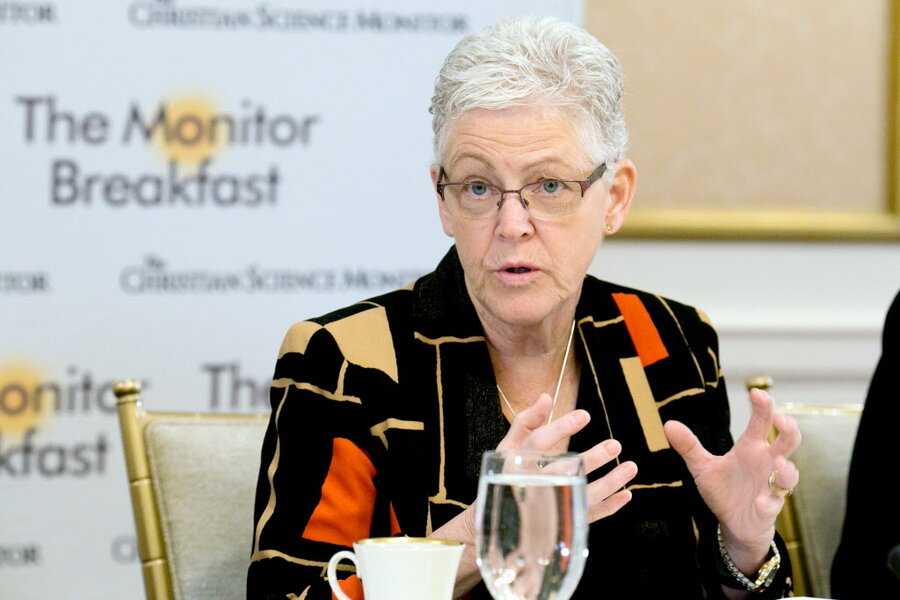World leaders poised to seal landmark emissions deal in Vienna
Loading...
In 1987, the Montreal Protocol set the ozone layer on the path to recovery. In 2016, it could take a bite out of greenhouse gas emissions.
Officials convened in Vienna this week to amend the Montreal Protocol, which phased out ozone-killing refrigerants called CFCs nearly three decades earlier. Now the delegation is nearing an international deal to reduce HFCs, says EPA administrator Gina McCarthy.
“We are seeing all countries coming into this meeting with an incredibly positive and collaborative energy level,” Ms. McCarthy said at a press conference on Thursday. “There is no country that appears to be standing on the sidelines in this discussion.”
Chlorofluorocarbons (CFCs) are organic compounds composed of carbon, chlorine, and fluorine. CFCs, which were commonly used in air conditioners and aerosol cans, catalyze the conversion of ozone (O3 ) to oxygen (O2 ). In the 1970s, researchers found that atmospheric CFC levels were weakening Earth’s protective ozone layer.
The Montreal Protocol, signed by all UN and EU member nations in 1987, laid out plans to phase out CFCs. But in doing so, it created a new problem.
Manufacturers replaced CFCs with hydrofluorocarbons (HFCs). By comparison, these compounds were ozone-friendly and worked about as well in refrigerants. But later research indicated that HFCs are potent greenhouse gases, contributing significantly to climate change.
International officials have reconvened in hopes of amending the Montreal Protocol to include HFC limits. The EPA has stated that a global reduction in HFCs could prevent 0.5 degrees Celsius in warming over the next century. It doesn’t sound like much, but it’s a moderate step in suppressing climate change.
Before the Paris climate agreement, Earth was on track to warm 4.5 degrees Celsius by 2100. If the measures of that agreement are fully implemented, that number drops to 3.5 degrees. According to some climate scientists, significant environmental implications will result from an increase of 2 degrees. Others say the safe number is an even lower 1.5 degrees.
“A half degree is a substantial chunk of that, but obviously it doesn’t solve the problem,” says Noelle Eckley Selin, a professor at MIT’s Department of Earth and Atmospheric Sciences, in an interview with The Christian Science Monitor. At MIT, Professor Selin leads a research group that uses atmospheric chemistry models to inform policy decisions.
“I would characterize it as a moderate step,” Selin says. “It is quite a chunk of the emissions reduction we need, but we’re not going to get there without attacking CO2.”
In a warming world, limiting HFCs won't be easy. Air conditioners are a rapidly growing market in some smaller and developing nations – a transition away from HFCs could have a critical impact on the economies of those countries. And in countries like India, where summer climates can push 120 degrees, cost efficient air conditioners are essential. As warming trends continue in coming years, demand for cooling technology will only increase.
“These are very real issues that countries face in implementing climate action,” Selin says. “At what speed can you require industries to make changes? How does that affect the economy? Even if you agree with every analysis that scientists put forward, it’s still a very difficult thing to agree on when balancing other priorities.”
The delegation has yet to find a solution that will satisfy both science and commerce. The Island States, which include the Marshall Islands, Kiribati, and the Solomon Islands, recommended a slower reduction rate for developing nations. India proposed a 15 year grace period before smaller countries were required to begin weaning off HFCs.
McCarthy has stated that negotiators are nearing a mutual agreement, and could reach an agreement by Saturday. A major goal, McCarthy says, is to complete the amendment in 2016 – before President Obama leaves office.








